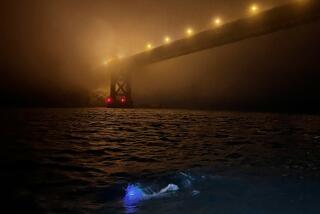WET & WILD : Aquatics Enthusiast Sinks to New Lows
- Share via
We begin with a warning: If you feel the least bit claustrophobic, don’t try operating a one-man submarine.
There I was, embedded tight in the belly of a 4-by-10-foot mass of plastic and metal constituting what had been billed as the world’s most accessible underwater craft. Lying face down, locked in as tightly as a match in a matchbox, I could feel the ship’s walls touching my hips.
In a few minutes a hoist would lift the contraption with me in it off the deck of a jet-ski barge and into the cold water off Catalina Island. Then, operating with only a few clumsy controls, I would be cruising amid the kelp and fish beneath the surface of the Pacific Ocean.
The anticipation churned my stomach.
Then the training kicked in. All 2 1/2 hours of it. I remembered my teacher’s instructions on how to check for leaks when you first hit the water and how to flood the vessel’s ballast tanks with seawater, beginning its slow downward spiral.
Suddenly there was a lurch as the hoist began its work. First I was swinging free, careening back and forth between the deck and the water. Then, with only a slight splash marking my entry into the proper element, I began my slow descent, sinking into the murkiness with no indication of movement except the agonizingly methodical climb of the needle on the depth gauge mounted in front of me.
“Give me a cabin pressure reading,” cracked the voice of my instructor through the small speaker just inches from my ear.
Glancing at the proper gauges, I croaked out a series of numbers.
Below each flood switch was a tiny dial, a twist of which would begin replacing the seawater in the ballast tanks with air. By carefully fiddling with the two sets of controls, my instructor had said, I would be able to regulate my buoyancy much like a diver using a buoyancy compensator; negative for descent, positive for ascent and somewhere in between for neutral.
By gripping a bar directly below and in front of me I could adjust the angle of my two thrusters, controlled by forward, reverse and neutral toggle switches mounted in a box near my left hand. And over my right shoulder to the rear was an oxygen intake valve by which to change the cabin pressure or atmospheric mix when necessary.
That was it; not too complicated even for a guy whose technical education stalled in sixth grade.
Suddenly I felt a dull thud as my steel contraption settled on the ocean floor. Glancing at the gauge, I read a depth of 85 feet. All I could see through my window was a huge clump of fluttering kelp interspersed with fish.
This weird little boat, dubbed the Sea Urchin, took its maiden voyage about a year ago in Vancouver, Canada, where a company called Sea Urchin Inc. developed it for research and commercial purposes.
Marketing experts, however, quickly realized that the new sub’s simplicity and ease of operation might have recreational potential. So they began testing the market--first in Vancouver, then in New Orleans. And last month they began operating the submarine under the auspices of Avalon Aquatics, a dive shop on Catalina Island, offering 2 1/2 hours of instruction and a half-hour self-guided “flight” to anyone older than 16 willing to pay $199.
“We’re trying to put submersibles within reach of the general public,” explained Jonathan Council, the company’s operations manager who spends most of his time these days on the jet-ski barge off Descanso Beach helping newly trained submarine pilots.
Under the company’s agreement with the dive shop, Council said, the sub will stay at Catalina until about the end of September before moving on to the Florida Keys and, later, Hawaii. If the attraction proves popular, he said, Catalina will eventually have a sub of its own.
“It’s a new experience,” Council said, adding that about 27 people had piloted the Sea Urchin--which weighs 1,500 pounds on land and is worth about $65,000--during its first two weeks on the island. “It’s not the kind of thing you look in the phone book for.”
To assure the safety of first-time pilots, the sub remains on a long tether attached to the barge and is accompanied on each voyage by at least two safety divers. More than 250 trips have been logged without mishap, Council said.
That knowledge offered comfort while I lay bobbing on the bottom. Once I got the hang of it, however, no comfort was needed: There was simply no place I’d rather have been than down there flipping switches to turn the craft this way and that, left and right, up and down.
The view from the window, I must say, was rather restricted; you can see a lot more wearing scuba gear. But I’d seen the bottom before, and this was a new kind of experience. While diving is physical, this was mechanical ; I was inching my way along the ocean floor using a whole new set of skills.
When Council interrupted to announce that it was time to return topside, it felt like an intrusion. Reluctantly I obeyed his instructions to open the three valves that blew air into the submarine’s tanks. Then, easing my concentration, I peered into the water as the little machine began slowly ascending like a bubble-bearing bottle.
Breaking the surface was a ego-gratifying experience. Suddenly light streamed in through the bubble above me as I heard the faint cheers of Council and his cohorts on deck. I felt a bit like Jacques Cousteau. It’s not every day, after all, that a man can be an aquanaut.
“Everyone who goes down comes up with a smile,” Council assured me.
I think mine is still on my face.
You can get yours by calling Avalon Aquatics at (800) 677-2822.


